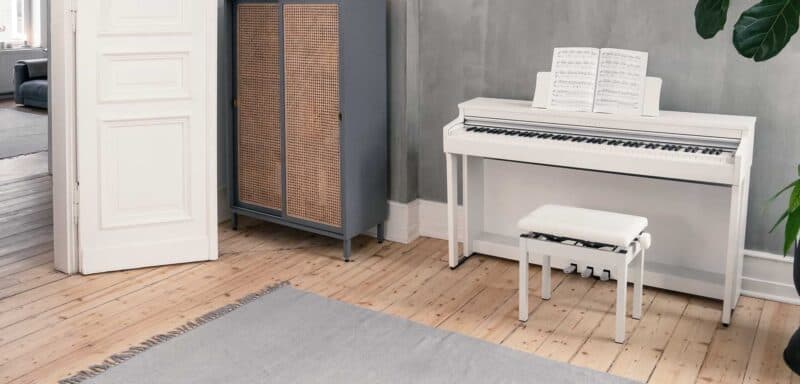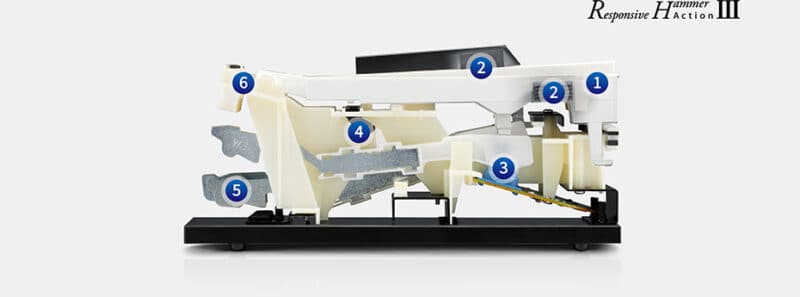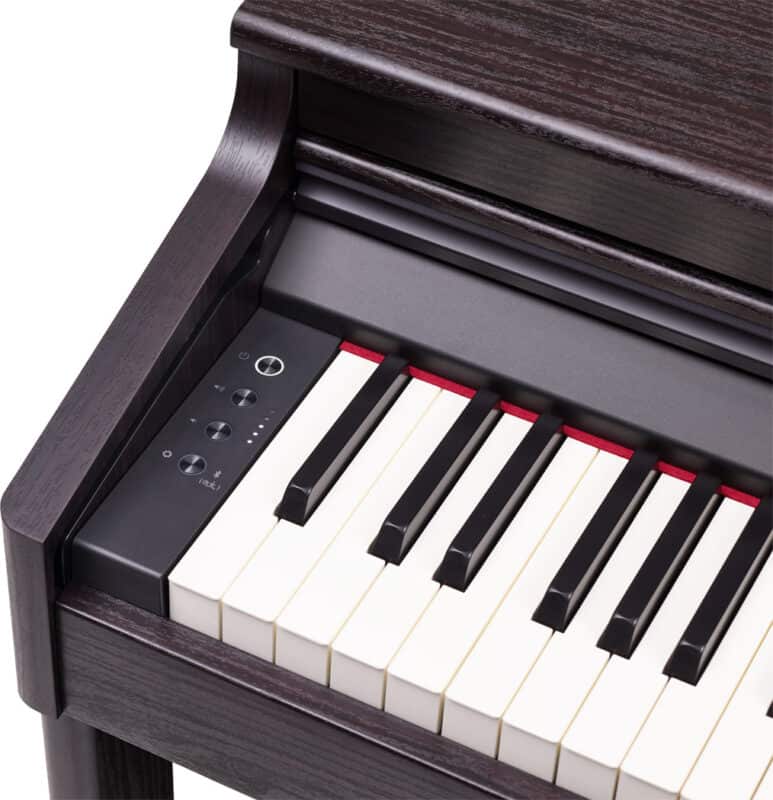With the massive improvement in digital piano technology over the past decade or so, it’s gotten to the point that even some mid-range models have emerged as legitimate alternatives to a used upright piano for many families seeking an instrument for a beginner or intermediate player.
Today we’ll be comparing two such models as we look at Kawai‘s new CN201 and Roland‘s RP701. Both are big sellers globally and serve as a great replacement for folks considering a used upright piano and concerned about potential reliability issues and maintenance requirements that come with the territory.
We’ll be comparing everything relevant about these two instruments, and hopefully, if you’re looking for an upright piano alternative or simply looking for a piano in this category you’ll find this article and accompanying video helpful. Maybe even one of these will be a finalist on your wishlist.
Kawai CN201 vs Roland RP701 – Background
The Kawai CN201 digital piano is a pretty recent release and serves as an upgrade to the much beloved CN series precursor; the CN-29. We’ve done a number of comparisons with it already, but one we were definitely excited about was to see how the CN201 compares with the Roland RP701.
These two home pianos are really well-matched for a number of reasons, the least of which is the fact that they’re priced in the same ballpark and are aimed at the same end user, i.e. someone seeking a high-quality home digital piano that looks good and performs at a high level musically.
With the CN201, we have an instrument that remains very much focused on the pianistic experience with regard to piano sound, touch and speaker quality. With the RP701, Roland is more focused on offering a nice breadth of experience in terms of the range of sounds, available features, and everything possible with the app.
With that in mind, the CN201 sits poised to be the slight favorite here for people primarily focused on an acoustic piano replacement. For people looking for a nice, well-rounded experience in which piano playing will stay play a large role without being the singular focus, the RP701 brings a very strong value proposition to the table.
Piano Sound
Kawai CN201

Kawai’s Progressive Harmonic Imaging Sound Engine
As mentioned above, the CN201 is the successor to the CN29, which was a massive seller for us over here at Merriam Pianos during its run. For the price point, the speaker quality, the action, and especially the SK-EX sample set were really market-leading for the class.
By and large, everything that made the CN29 great remains intact here, but there are a couple of meaningful differences. Kawai’s main chip supplier Onkyo, who was responsible for the amplifier and much of the digital signal processing, went out of business, so we’re working with a new chip supplier with new digital signal processing here.
So, even though on paper the CN201 brings back the Progressive Harmonic Imaging sound engine, it’s actually a refined version of the engine courtesy of the newly improved signal processing. The improvement is more pronounced when playing with headphones as it sounds like the Spatial Headphone Sound effect has been a large benefactor of the new chip supplier.
The Shigeru Kawai SK-EX concert grand piano with 88 key individual note sampling remains the core sample, but the EX sample makes a return, and Kawai has added the new K-60 upright piano sample, making for three very high-quality piano tones each of which boasts 88-key single note sampling.
Toggling between the two core grand piano samples and the difference is quite pronounced, to the point that we think Kawai even recorded them differently with different mic placements. For our money, the SK-EX is probably the top piano sound in the class with an incredibly dynamic and colorful palate with which the player gets to work.
The new K-60 also happens to be a fabulously rendered upright piano sample, which is great because generally upright piano patches are a throw-in that isn’t taken seriously. For certain styles of music, this sample would work extremely well.
Virtual Technician
Via the Virtual Technician feature available on the PianoRemote app, you can edit up to 18 sound-related parameters to adjust the sound to your liking including things like Touch Curve, Voicing, Damper Noise and Damper Resonance.
The CN201 also has some adjustable reverb settings as well, and a Low Volume Balance feature.
Polyphony
The polyphony remains the same on the CN201 from the CN29 at a cool 192 notes, and for any type of solo piano playing this is going to be more than sufficient.
Other Sounds
Once you move past the three core samples, there are a few more acoustic piano samples which are actually just variations based on those main samples, making for 8 total acoustic piano patches.
Beyond this, there are 11 further sounds consisting of a pair of electric pianos, organs, strings, some synthesizer pads and a couple of others, for 19 total sounds.
As is sometimes the case with Kawai, the non-acoustic piano tones here feel a little bit like an afterthought. If you were looking for a great string sample or expansive collection of e-pianos, for example, we don’t think you’ll want to turn to the CN201. The CN201 is built for its acoustic piano tones, and that’s just fine but worth noting.
Speakers
One of the highlights of the CN-29 was the onboard speaker sound system, and that’s sure to be the case here again with another 40-watt, dual speaker system at the helm.
40 watts of power is pretty much right at the top of what you can expect in this price range, and there’s more than enough power here to fill a small to mid-sized room.
The bass presence in particular is really strong here on the CN201.
Roland RP701 Digital Piano

Roland’s SuperNATURAL Piano Technology
Heading over to the Roland RP 701, it’s obvious that the acoustic piano experience is very different here.
The RP701 is equipped with Roland’s SuperNATURAL Piano Sound engine, but it’s important to note that the version here is still a sample-based tone engine as opposed to the modeling-based versions of the engine available in some of Roland’s more expensive models.
There’s a total of 14 different acoustic piano patches here, but the core acoustic piano tone is definitely the highlight.
Like the CN201, the tone also happens to be rich, and very dynamic, which was somewhat of a problem on some Roland models in the past, wherein the tone didn’t behave quite as an acoustic piano tone does at different dynamic levels.
Courtesy of Roland’s new BMC sound processing chip, the timbre of the tone naturally shifts depending on how hard or soft you play, greatly improving the sound quality.
Piano Designer
Like Kawai, Roland also allows the user the ability to edit the piano tone courtesy of the Piano Designer function.
In the case of the RP701, the user is able to tweak the damper resonance, key-off resonance, string resonance, lid height and more.
Polyphony
The RP701 is packing even more polyphony than the CN201 with a very strong 256-note polyphony count.
From a purely piano-playing standpoint, the extra polyphony here isn’t really going to be noticeable. But it does speak to the overall processing capabilities of the BMC sound chip here.
Other Sounds
In contrast to the CN201, the RP701 has 324 total built-in sound presets, representing a very extensive range of different sounds.
Many of these sounds are what would be referred to as core tones, and this includes electric pianos, organs, synths, harpsichords, strings and pads. The non-acoustic piano core tones here are definitely punching above what the CN201 is offering.
Once you’re past the core sounds, the entire General MIDI 2 bank takes over. Navigating the tones is really easy courtesy of a data wheel that makes it easy to jump between categories and individual tones.
Speakers
The RP701 is working with a pair of 12 watts of speakers for a total of 24 watts of power. If you’re doing a lot of playing with headphones, the difference in speaker power between these two pianos is irrelevant.
And while you can’t really tell the difference in the mid-range or the high-end of either piano and frankly, there are moments where we actually prefer the high-end presentation on the RP701 versus the CN201, the low-end on the RP701 definitely doesn’t stand up to the power and presence that the 201 is generating.
So, there is a measure of compromise that you will need to weigh out in terms of the speaker presentation and bass presence vs the quantity and quality of non-acoustic piano tones.
Sound Wrap Up
Ultimately we’re dealing with a very different piano experience between these two instruments in terms of the tone. The core acoustic piano tone on the CN201 paired with the speakers on board to us delivers an overall more authentic grand piano experience.
On the other hand, the RP701 is still delivering a very strong acoustic piano tone, and of course offers a much wider selection of tones, of which the non-acoustic piano tones are decidedly superior to what the CN201 has to offer.
Piano Action

Kawai’s Responsive Hammer III Action
The CN201 is equipped with the Responsive Hammer III (RHIII) action, which going by the title appears to be the same action that was used in the CN29. While the name of the action remains the same, this is in fact an enhanced version of the RHIII action with improved key cushioning.
We think the events of the last few years suddenly made key cushioning a big deal for a lot of people because they realized that digital pianos’ key actions, even with headphones, still make a lot of noise. As a result, improving the cushioning of key actions to reduce mechanical action noise has become a priority for Kawai, Roland, Yamaha, Casio and Korg.
Otherwise, the RHIII stays the same with a triple sensor, counterweights, escapement (let-off), ivory touch key surfaces on the white keys and a matte finish on the black keys. The newly improved cushioning makes it one of the quietest actions on the market, and it should also be durable in the long term.
The RHIII was already arguably the top plastic key action available in a digital piano with excellent, weighting, responsiveness and repetition speed, and somehow Kawai has managed to make it even better here.
Roland’s PHA4 Standard Keyboard Action
Over on the RP701, we’ve got the Roland PHA-4, which is a staple throughout much of Roland’s lineup and can be found on other models like the Roland F701, FP60X, RD88 and several more.
The PHA-4 also features a triple sensor, escapement and textured keytops, though the texture is a little bit more pronounced than the RHIII. The PHA-4 is a slightly heavier action compared to the RHIII, but not excessively heavy.
Both of these actions are among the best constructed in terms of reliability, and the touch sensitivity MIDI output can’t be beaten for the class.
So, both piano actions are very good overall, and you can’t go wrong with either one. We would say the RHIII feels a little bit more like a grand piano action, and the repetition speed is a little bit faster. That’s not to take anything away from the PHA4 which also happens to have many passionate advocates, and also boasts the authentic feel of an acoustic piano.
Features/Connectivity

User Interface
Roland and Kawai took different approaches to the user interface here. The CN201 features a redesigned cheek block control panel, whereas the RP701 has a number of buttons spread out across the front panel and an OLED display.
The cheek block approach is becoming a little bit more popular these days because it cuts down on buttons and makes the instrument look less like a digital piano, but the RP701 is still offering a very traditional look otherwise.
Both interfaces are intuitive and easy to use.
Bluetooth MIDI and Audio Connectivity
Both pianos are offering full Bluetooth connectivity with both Bluetooth MIDI and Bluetooth Audio on board. This is nice to see as previous versions of these two models did not offer any Bluetooth Audio.
Bluetooth Audio allows you to stream music through the piano’s onboard speakers, while Bluetooth MIDI allows you to wirelessly connect to an iOS or Android device to access apps, such as the Roland Piano App (replaces Piano Every Day), and the Kawai PianoRemote and PiaBookPlayer apps.
Other Connectivity
When it comes to other connectivity, both of these pianos are fairly light, which really speaks to the fact that both are built to sit in a living room and be used by the whole family, as opposed to studio or stage instrument which requires more extensive connectors.
Both pianos offer dual headphone outputs, as well as USB type A. That’s it for the CN201 other than a spot for the ac adaptor power supply of course, whereas the RP701 also has USB type B and a stereo mini line in.
The lack of discreet line outputs means you would need to fiddle with one of the headphone jacks if you needed to connect to an amp, so keep that in mind.
Functions
Both pianos have a fairly standard complement of features one would expect from a home-based digital piano.
Metronome, transpose (in semitones), split, layer, twin piano (duet mode), four hands mode and internal songs are available on both, though there are substantially more internal songs on the RP701. Both pianos also have a preloaded lesson function with books from Alfred, Beyer, Chopin, Czerny and more.
Both have internal recorders, though the CN201 is a MIDI recorder, while the RP701 has both a MIDI recorder and an Audio recorder that can record WAV files leading to more playback options as well.
Cabinet & Finish Options
Both pianos come with elegant cabinetry built to capture the look of a traditional upright piano. Both manufacturers have really upped their cabinetry game in recent years, though the RP701 still feels a little bit more substantial than the CN201.
Both pianos also come with handy music rests and integrated triple pedal systems (soft, damper and sostenuto) with continuous detection damper pedals. Kawai calls theirs the Grand Feel Pedal System as the spring tension is matched to an acoustic grand piano.
The CN201 is available in three finish options; Premium Rosewood, Satin Black and White. The RP701 is available in four finishes; Dark Rosewood, Light Oak, Contemporary Black and White.
Both pianos of course also ship with an owner’s manual.
Closing Thoughts
As we’ve said a couple of times now, for folks primarily focused on the piano-playing experience, the CN201 really shines. For folks looking for a legit acoustic piano replacement, the CN201’s combination of action, tone and speakers really delivers a sensational experience for the price.
Over on the RP701, we have a piano with a broader feature set and substantially more onboard tones. You’re also getting excellent action, and even if the speakers lack the bass presence of the 201s, the mid and upper ranges perform equally well.
If you’re going to be using headphones primarily, the decision really comes down to your preference between action, piano sample and if you need a large variety of tones. If you’ll be using the built-in speakers and you’ve got a bigger space to fill, there’s no question that the CN201 is going to fill that space a little bit better.
We sell virtually equal numbers of these two instruments in our stores so for all the pros and cons we’ve listed, people are pretty equally divided in terms of the ones that end up being the best fit for them. Warranty coverage is great with both manufacturers, so in either case, you can rest assured you’re getting a well-built instrument.
Thanks for reading!

